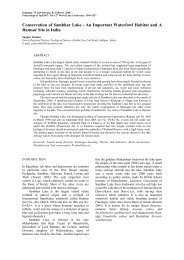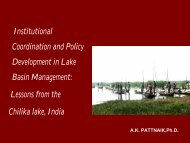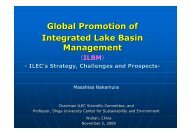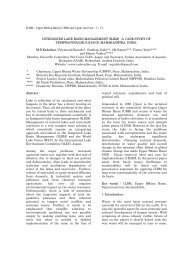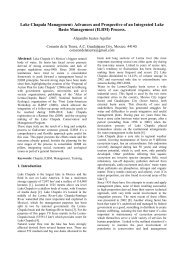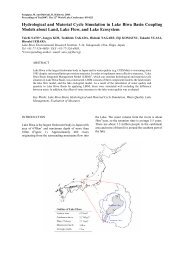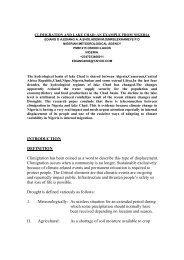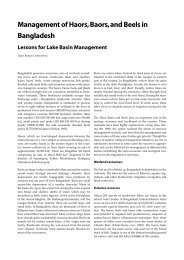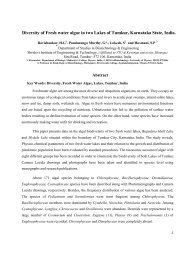Chromium showed site specific bioaccumulationby parasites show<strong>in</strong>g higher concentration <strong>of</strong> metalcontent between parasites and host <strong>in</strong> site 2. This may<strong>in</strong>dicate environmental <strong>in</strong>fluence on the heavy metal,rather than the measured contents <strong>in</strong> fish that may<strong>in</strong>terfere with the physiological functions <strong>of</strong> theparasites <strong>in</strong> the host. In site 2, we observed golddeposits along the river bed that may <strong>in</strong>terfere with themetal accumulation <strong>in</strong> the fish. This variability, reflectthe mobility <strong>of</strong> the fish host and can obscure thedifferences that might be detected between sites.When the metal accumulation <strong>in</strong> fish parasitesand fish was compared <strong>in</strong> the enriched lake waterfrom site 1, the results are as shown <strong>in</strong> Tab. 3. Inenriched lake water, there was higher bioaccumulation<strong>of</strong> metals by a rang<strong>in</strong>g from 10 times to 35.Bioaccumulation is a well documented field <strong>of</strong>research (Ra<strong>in</strong>bow, 2007; Zimmermann et al., 2004;Sizmur and Hodson, 2009). Normally,bioaccumulation <strong>of</strong> metals is through highly specificphysiological uptake mechanisms (Chapman, 1997;Ra<strong>in</strong>bow, 2007) and reflects its exposure to pollutantsover time. Metals accumulate more rapidly than canbe elim<strong>in</strong>ated due to low molecular weights, metalb<strong>in</strong>d<strong>in</strong>g prote<strong>in</strong>s, such as metallothione<strong>in</strong>s (MT’s) andpresent <strong>in</strong> aquatic organisms. In addition, MT’scontrol the bioavailability and the k<strong>in</strong>etics <strong>of</strong>bioaccumulation as well as the toxic effects that occurvia the <strong>in</strong>duction <strong>of</strong> their biosynthesis (Baudrimont etal., 2003). For most fish, these <strong>in</strong>tracellular prote<strong>in</strong>sb<strong>in</strong>d specifically and have a high aff<strong>in</strong>ity for metals,such as Cd, Cu and Zn.In the aquatic environment, factors that canaffect bioaccumulation <strong>of</strong> metals <strong>in</strong>clude:environmental conditions, presence <strong>of</strong> specificbioavailable metal species (Ra<strong>in</strong>bow and Dall<strong>in</strong>ger,1993; Van G<strong>in</strong>neken et al., 1999), trophic status <strong>of</strong>bioaccumulation, physiological condition <strong>of</strong> theorganism, <strong>in</strong>teractions between metals and the uptakeand release rates (k<strong>in</strong>etics) <strong>of</strong> metals by an organism(Buchwalter and Luoma, 2005). In fish-parasiteassociation, the normal physiological function<strong>in</strong>g <strong>of</strong>fish is <strong>in</strong>terrupted though it is not clear, which amongthese factors will exert great control over metals <strong>in</strong> thefish system.Metal concentration <strong>in</strong> L. <strong><strong>in</strong>test<strong>in</strong>alis</strong> (mg kg -1 dw)the parasite tissues, albeit the <strong>in</strong>creased Pb and Crcontent <strong>in</strong> parasite relative to the fish tissues was morepredictable than the changes <strong>in</strong> Cd (Fig. 3). Thissuggest an uptake <strong>of</strong> metal by parasites from the fishtissues as the metal content <strong>in</strong> R. argentea <strong>in</strong>creasecomparable to the studies <strong>in</strong>volv<strong>in</strong>g heavy metaluptake k<strong>in</strong>etics <strong>in</strong> parasites <strong>in</strong> fish tissues. On theother hand, <strong>in</strong>creased Cu burden <strong>in</strong> the fish tissues wasassociated with l<strong>in</strong>ear reduction <strong>of</strong> the Cu <strong>in</strong> thetissues <strong>of</strong> the parasites. The present decl<strong>in</strong>e <strong>in</strong> Cu <strong>in</strong>parasite host as it <strong>in</strong>creases <strong>in</strong> fish host was <strong>in</strong>terpretedas elemental competition for essential element.Parasites and fish host have been shown to competefor several elements such as Ca, Cu, Fe, Zn and Sr <strong>in</strong>perch (Sures, 2002). Though there is paucity <strong>of</strong> dataon studies deal<strong>in</strong>g with simultaneous analysis <strong>of</strong>different elements <strong>in</strong> fish, and even less studiesdeal<strong>in</strong>g with metal k<strong>in</strong>etic and metal metabolism <strong>in</strong>fish-parasite association, it is probable thatcompetition for elements between host and parasitesfor essential elements could lead to <strong>in</strong>creasedabsorption <strong>of</strong> other essential metals <strong>in</strong>clud<strong>in</strong>g Cu.Concentrations <strong>of</strong> Cu may be regulated by the fish aswell as by the parasite, albeit the physiologicallyrequired levels are actually higher <strong>in</strong> the parasite.These higher Cu concentrations should therefore notbe construed as bioaccumulation <strong>of</strong> environmentalpollutants.50.040.030.020.010.00.05.04.03.02.01.0Pb y = 3.6564x + 1.273R 2 = 0.57220.0 2.0 4.0 6.0 8.0 10.0Cr14.0y = 4.2418x + 0.9463R 2 = 0.60012.402.001.601.200.800.4012.010.08.0Cd y = 7.1748x + 0.3049R 2 = 0.4240.05 0.10 0.15 0.20 0.25Cuy = -0.9226x + 15.835R 2 = 0.4985Tab. 3 Heavy metal concentration <strong>in</strong> fish, parasite andthe overall bioaccumulation factor0.00.0 0.2 0.4 0.6 0.8 1.0 1.26.03.0 4.0 5.0 6.0 7.0 8.0Heavy metal concentrationBioconcentrationHeavymetals Fish Parasite factorPb36.22 ± 4.2 421.65 ± 10.2 11.6Cd0.78 ± 0.12 27.6 ± 1.92 35.4Cr3.95 ± 0.42 42.65 ± 1.44 10.8Cu11.01 ± 1.12 102.4 ± 5.55 10.2Increased content <strong>of</strong> Pb, Cd and Cr <strong>in</strong> R. argentearesulted to correspond<strong>in</strong>g <strong>in</strong>crease <strong>of</strong> these metals <strong>in</strong>Fig. 3. Regression models show<strong>in</strong>g the relationshipsbetween metal concentration (mg kg -1 dw) <strong>in</strong> L.<strong><strong>in</strong>test<strong>in</strong>alis</strong> aga<strong>in</strong>st metal concentration <strong>in</strong> <strong>Ligula</strong><strong><strong>in</strong>test<strong>in</strong>alis</strong>4. ConclusionHeavy metal concentration <strong>in</strong> R. argentea (mg kg -1 dw)The present study shows that the L. <strong><strong>in</strong>test<strong>in</strong>alis</strong> <strong>in</strong>R. argentea accumulates heavy metals <strong>in</strong> variablequantities <strong>in</strong> fish host. Some heavy metals such as Pb,Cd and Cr were bio accumulated by upto factor 11, 18and 14 respectively and Cu by factor 2.5 <strong>in</strong> the fish4
<strong>endoparasites</strong> <strong>in</strong> the natural water environment. Whenthe metal content <strong>in</strong> water with<strong>in</strong> the experimentalunits conta<strong>in</strong><strong>in</strong>g fish and parasites were <strong>in</strong>creased tenfoldthan metal concentration <strong>of</strong> the lake water <strong>in</strong> thelaboratory, all heavy metal concentrations <strong>in</strong> L.<strong><strong>in</strong>test<strong>in</strong>alis</strong> <strong>in</strong>creased between 10 to 35 time higherthan the concentration <strong>in</strong> tissues <strong>of</strong> its host. WhereasCu was demonstrated to be subject <strong>of</strong> elementcompetition between fish and parasite, Pb, Cd and Crdisplayed a partition<strong>in</strong>g <strong>in</strong> the fish host with parasiteshav<strong>in</strong>g higher concentration <strong>of</strong> these metals, whichwould render the <strong>Ligula</strong> <strong><strong>in</strong>test<strong>in</strong>alis</strong> <strong>in</strong> R. argenteahost a suitable as bio-monitor for exposure to thesemetals. It is evident that L. <strong><strong>in</strong>test<strong>in</strong>alis</strong> is sensitive<strong>in</strong>dicator and early warn<strong>in</strong>g sign for <strong>in</strong>creas<strong>in</strong>g Pb, Cdand Cr pollution. Given that the parasite is easy toidentify even <strong>in</strong> different host (Olson et al. 2000;Tek<strong>in</strong>-Özan and Kir Tek<strong>in</strong>-Örzan and Barlas 2008), itshigh abundance and high prevalence, it was found tobe suitable bio-monitor model for early warn<strong>in</strong>g signfor localized pollution by Pb, Cd and Cr <strong>in</strong> LakeVictoria.AcknowledgmentsThe authors would like to thank the RoyalNetherlands Embassy <strong>in</strong> collaboration with VictoriaInstitute for Research on Environment andDevelopment (VIRED) International for fund<strong>in</strong>g thisproject. The LVEMP Project also provided additionalsupport to which we are grateful. The authors thankMr. Lewela <strong>of</strong> Moi University, Biochemical Analysislaboratory for the <strong>in</strong>valuable assistance <strong>in</strong> samplecollection and analysis <strong>of</strong> heavy metals.References[1] B. Sures, Accumulation <strong>of</strong> heavy metals by <strong>in</strong>test<strong>in</strong>alhelm<strong>in</strong>ths <strong>in</strong> fish, facts, appraisal and perspectives.Parasitol. 126: 53-60, 2003.[2] B. Sures, Environmental parasitology: relevancy <strong>of</strong>parasites <strong>in</strong> monitor<strong>in</strong>g environmental pollution. Trends<strong>in</strong> Parasitol. 20(4): 170-177, 2004.[3] B. Sures, H. Taraschewski, and E. Jackwerth, Leadaccumulation <strong>in</strong> Pomphorhyncus laevis and its host. J.Parasitol. 80: 355-357, 1994a.[4] B. Sures, H. Taraschewski, and E. Jackwerth, Leadcontent <strong>of</strong> Paratenuisentis ambiguous (Acanthocephala),Anguillicola crassus (Nematodes) and their hostsAnguilla anguilla. Dis. Aquat. Org. 19: 105-107, 1994b.[5] B. Sures, H. Taraschewski. and E. Jackwerth,Comparative study <strong>of</strong> lead accumulation <strong>in</strong> differentorgans <strong>of</strong> perch (Perca fluviatilis) and its <strong>in</strong>test<strong>in</strong>alparasite Acanthocephalus lucii. Bull. Environ. Contam.Toxicol. 52: 269-273, 1994c.[6] B. Sures and H. Taraschewski, Cadmium concentration<strong>in</strong> two adult acanthocephalans, Pomphorynchus laevisand Acanthocephalus lucii, as compared with their fishhosts and cadmium levels <strong>in</strong> larvae <strong>of</strong> A. lucii ascompared with their crustacean host. Parasitol. Res. 81:494-497, 1995.[7] B. Sures, R. Siddall. and H. Taraschewski, Parasites asaccumulation <strong>in</strong>dicators <strong>of</strong> metal pollution. Internat. J.Parasitol. 33: 65-70. 1999.[8] J. Dvoracek, F. Tenora, V. Barus, and S. Kracmar,Concentrations <strong>of</strong> some heavy metals <strong>in</strong> <strong>Ligula</strong><strong><strong>in</strong>test<strong>in</strong>alis</strong> plerocercoids (Cestoda) and Philometraovata (Nematoda) compared to some their hosts(Osteichthyes). Helm<strong>in</strong>thol. 37(1):15-18, 2000.[9] B. Sures, The use <strong>of</strong> fish parasites as bio<strong>in</strong>dicators <strong>of</strong>heavy metals <strong>in</strong> aquatic ecosystems, a review. Aquat.Ecol. 35: 245-255, 2001.[10] C. Schludermann, S. Konecyny, S. Laimgruber, J.W.Lewis, F. Schiemer, A. Chovanec. and B. Sures, Fishmacroparasites as <strong>in</strong>dicator <strong>of</strong> heavy metal pollution <strong>in</strong>river sites <strong>in</strong> Austria. Parasitol. 126: 61-69, 2003[11] B. Sures and N. Reimann, Analysis <strong>of</strong> the trace metals<strong>in</strong> the Antactic host-parasite system Nototheniacoriiceps and Aspersentis megarhynchus(Acanthocephala) caught at K<strong>in</strong>g George Island, SouthShetland Islands. Polar Biol. 26: 680-686, 2003.[12] F. Thielen, S. Zimmermann, F. Baska, H. Taraschewski,and B. Sures, The <strong>in</strong>test<strong>in</strong>al parasite Pomphorhyncuslaevis (Acanthocephala) from barbel as bio<strong>in</strong>dicator formetal pollution <strong>in</strong> the Danube River near Budapest,Hungary. Environ. Pollut. 129: 420-429, 2004.[13] B. Sures, Host-parasite <strong>in</strong>teractions from anecotoxicological perspective. Parasitol. 47(3): 173-176,2007.[14] S. Tek<strong>in</strong>-Özan and I. Kir, Comparative study on theaccumulation <strong>of</strong> heavy metals <strong>in</strong> different 291 organs<strong>of</strong> tench (T<strong>in</strong>ca t<strong>in</strong>ca L. 1758) and plerocercoids <strong>of</strong> itsendoparasite <strong>Ligula</strong> <strong><strong>in</strong>test<strong>in</strong>alis</strong>. Parasitol. Res. 97:156-69, 2005.[15] S. Tek<strong>in</strong>-Özan, and M. Barlas, Concentration <strong>of</strong> heavymetals <strong>in</strong> <strong>Ligula</strong> <strong><strong>in</strong>test<strong>in</strong>alis</strong> L., 1758 plerocercoids(Cestoda) compared to its host’s (T<strong>in</strong>ca t<strong>in</strong>ca L., 1758)organs from Beyşehir Lake (Turkey). Helm<strong>in</strong>thol.45(2): 76-80, 2008.[16] B, Sures, Host-parasite <strong>in</strong>teractions from anecotoxicological perspective. Parasitol. 47(3): 173-176,2001.[17] R. Poul<strong>in</strong>, Evolutionary ecology <strong>of</strong> parasites: From<strong>in</strong>dividuals to community. Chapman and Hall Ltd:London, UK, 1998.[18] G.C. William, Natural selection: Doma<strong>in</strong>s, levels andchallenges. Oxford University Press: Oxford, UK, 1992.[19] S.N Luoma and P.S, Ra<strong>in</strong>bow, Metal contam<strong>in</strong>ation <strong>in</strong>aquatic environment. Science and lateral management.Cambridge University Press, 2008.[20] L.R. Shugart, Molecular markers to toxic agents. In:Ecotoxicol.: A hierarchical treatment, (Eds.) Newman,M.C. and Jagoe, C.H. Lewis Publishers, Boca Raton:139, 1996.[21] S.M. Adams, Biomarker/bio<strong>in</strong>dicator response pr<strong>of</strong>iles<strong>of</strong> organisms can help differentiate between sources <strong>of</strong>anthropogenic stressors <strong>in</strong> aquatic ecosystems.Biomarkers, 6(1): 33-44, 2001.[22] N.R Verrengia-Guerrero, M.G. Taylor, N.A. Davies,M.A.M. P.A. Lawrence. K. Simkiss, and E.A. Wider,Evidence <strong>of</strong> differences <strong>in</strong> the biotransformation <strong>of</strong>organic contam<strong>in</strong>ants <strong>in</strong> three species <strong>of</strong> freshwater<strong>in</strong>vertebrates. Environ. Pollut. 117: 523-530, 2002.[23] F Jirsa, M. Leodolter-Dvorak. and R. Krachler, Heavymetals <strong>in</strong> the nase, Chondrostoma nasus, L. 1758), andits <strong>in</strong>test<strong>in</strong>al parasite Caryophyllaeus laticeps, Pallas1781) from Austrian rivers, Bio<strong>in</strong>dicative aspects.Archiv. Environ. Contam<strong>in</strong>. Toxicol. 55(4): 619-626,2008[24] J.H. Wan<strong>in</strong>k, Prospects for the fishery on the smallpelagic Rastreneobola argentea <strong>in</strong> Lake Victoria.Hydrobiol. 407: 183-189, 1999.[25] J.A Neto, B.J Smith. and JJ. McAlister, Heavy metalconcentrations <strong>in</strong> surface sediments <strong>in</strong> a near-shoreenvironment, Jurujuba Sound, southeast Brazil.Environ. Pollut. 109: 1–9, 2000.5




